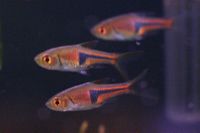Espe's Rasbora (Trigonostigma espei)
From The Aquarium Wiki
Espe's Rasbora
Trigonostigma espei
76 Litres (20 US G.)
2.5-4.1cm (1-1.6 ")
Freshwater
5.5 - 8
22.2-26.7°C (72 -80 °F)
1-12 °d
1:1 M:F
4-6 years
Family
Cyprinidae
Contents
Additional names
- Lambchop Rasbora, Espe's Rasbora, False Harlequin
Additional scientific names
- Rasbora heteromorpha espei, Rasbora espei
Origin[edit]
- This fish is native to Cambodia, and Thailand. A schooling species which most commonly inhabits soft, acidic bodies of water with lush plant growth, including pools, ponds, marshes and swamps. In the Mekong River of Cambodia these fish are caught for the aquarium trade by local fisheries using seines and traps.[1] Unlike the Celestial Pearl Danio this species has not been threatened by collection for the aquarium trade, but may one day face loss of habitat to forestry and agriculture.[2]
Sexing[edit]
- Specific gender ratios are not important unless breeding is desired, and sexing can be difficult. Like some other species of Rasborinae the females may be slightly larger than the males, and posses a more rounded belly. Males may be more colourful,[3] and have a downward point on the "lamb chop", where the females mark may be more rounded.[2]
Breeding[edit]
- Unlike most Cyprinids, which are “egg scatterers”, members of the Triginostigma genus attach their eggs to the underside of broad leaves. Spawning in home aquaria is unlikely as this species requires pristine, acidic, and very soft water for successful breeding.
Tank compatibility[edit]
- Swims primarily in the mid to upper levels of home aquaria, and will readily eat from the water surface. Keep in a minimum school size of 8-10 for the best displays of schooling behaviour. Because these fish are somewhat active, a minimum tank size of 20 gallons is recommended for beginners, and 10 gallons minimum for more advanced fish keepers. Acceptable tank mates include other small Cyprinids, peaceful Dwarf Cichlids, Corydoras, and smaller species of Gouramis.
Diet[edit]
- Will readily accept any small prepared, dried, frozen, and live foods. Choices include crushed flake, micro pellets, small brine shrimp, mosquito larvae, and daphnia.
Feeding regime[edit]
- Feed once or twice a day.
Environment specifics[edit]
- This species does require soft, acidic water to breed and but can tolerate moderately hard and alkaline water parameters as long as good water quality is maintained. Well planted tanks are recommended to provide both shade and hiding spaces, dark substrates to encourage best colouration, and with low to moderate water current.
Behaviour[edit]
- An active, and peaceful schooling species. Seem to enjoy spending some time "playing" in water currents created from filter outputs and water changes.
Identification[edit]
- Young and juvenile fish will look very similar to Trigonostigma heteromorpha or Harlequin Rasbora, and Trigonostigma hengeli, but the size and colouration of adult fish assist in differentiation. An adult T. espei is smaller than the former, possessing a bright bronze to copper iridescent colouration similar in distribution to T. heteromorpha, as well as intensely coloured eyes, and yellow to orange triangular colourations on the dorsal and caudal fins, but possesses a slimmer “lamb chop” shaped mark on the peduncle,[1] whereas the T. hetreromopha has a rosy colouration, and the hatchet mark is much larger and triangular.
- The more commonly confused T. hengeli is of similar size, but is mostly transparent with a intensely bright neon orange iridescent line over a slimmer peduncle mark, and has pale yellow or silver eyes.
Species Notes[edit]
- False Harlequin was a common named shared by T. espei and Trigonostigma hengeli but has largely fallen out of use due to the similar appearance of these two species and resulting confusion.
- This species was named after Heinrich Espe, who first imported these fish to Germany in 1967 [3] where it was identified by Meinken as Rasbora heteromorpha espei in the same year. Subsequent reclassification lead to the name Rasbora espei, which may be seen in publications predating the year 1999 in which Kottelat & Witte reassigned R. espei, and three other species, into the new genus Trigonostigma.[2]
Pictures[edit]
Additional Printed Resources[edit]
- “Beginners Luck: Breeding T. espei” Tropical Fish HobbyistMagazine. August 2006
- Kottelat, M. and K.E. Witte (1999) "Two new species of Microrasbora from Thailand and Myanmar, with two new generic names for small Southeast Asian cyprinid fishes (Teleostei: Cyprinidae)." J. South Asian Nat. Hist. 4(1):49-56.
References[edit]
- ↑ 1.0 1.1 Rainboth, W.J. (1996) Fishes of the Cambodian Mekong. FAO Species Identification Field Guide for Fishery Purposes. FAO, Rome, pgs. 4, 77. ISBN 92-5-103743-4 Available Here
- ↑ 2.0 2.1 2.2 Å hlander, O. Trigonostigma. Retrieved September 17, 2008 from Bollmoraakvarieklubb.org
- ↑ 3.0 3.1 Riehl, R., & Baensch, H. (1997) Aquarium Atlas (Vol. 1). (6th Revised English Ed.) (pp. 434) Vermont: Microcosm Ltd. IBSN 1-890087-12-2 (USA) IBSN 3-88244-050-3
External links[edit]
- Fishbase (Mirrors:
 )
)
